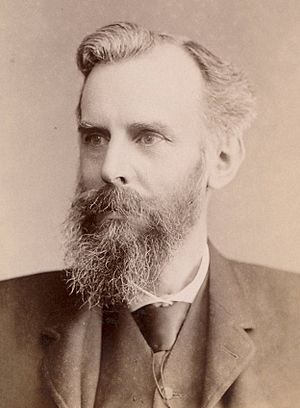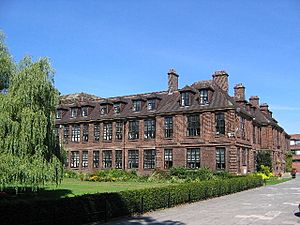John Venn facts for kids
Quick facts for kids
John Venn
|
|
|---|---|
 |
|
| Born | 4 August 1834 Kingston upon Hull, Yorkshire, England
|
| Died | 4 April 1923 (aged 88) Cambridge, England
|
| Alma mater | Gonville and Caius College, Cambridge |
| Known for |
|
| Awards | Fellow of the Royal Society (1883) |
| Scientific career | |
| Fields | |
| Institutions | Gonville and Caius College, Cambridge |
| Signature | |

John Venn (born August 4, 1834 – died April 4, 1923) was an English mathematician and thinker. He is famous for creating Venn diagrams. These diagrams are super helpful! They show how different groups of things relate to each other. You'll find them in subjects like math, computer science, and even when figuring out chances (probability).
In 1866, Venn wrote an important book called The Logic of Chance. In it, he explained his idea that probability (the chance of something happening) should be based on how often it actually happens, not just on guesses. Later, in 1881, he wrote another book, Symbolic Logic. This is where he really showed off what would become known as Venn diagrams.
Contents
John Venn's Life and Studies
John Venn was born on August 4, 1834, in Kingston upon Hull, England. His parents were Martha Sykes and Reverend Henry Venn. Sadly, his mother passed away when he was only three years old.
His family had a long history of working in the church. John grew up in a very strict home. His father was a big part of the Evangelical movement and helped set up churches overseas. His grandfather was also a pastor who worked with William Wilberforce, a famous person who fought to end slavery.
John started school in London in 1846. He later went to Gonville and Caius College, Cambridge in 1853. In 1857, he earned his degree in mathematics. He became a fellow at the college and, in 1903, he was chosen to be the President of the College. He held this important job until he died.
Following his family's tradition, John became an Anglican priest in 1859. He served in churches in Cheshunt and Mortlake.
Developing the Venn Diagram
In 1862, John Venn returned to Cambridge. He became a teacher of moral science. He spent his time studying and teaching about logic and probability theory.
Around 1869, he started giving special lectures to students from different colleges. It was these teaching duties that led him to create the diagrams that would eventually be named after him: the Venn diagrams.
John Venn also loved to build amazing machines. One machine he created was designed to bowl cricket balls. It was so cool that when Australian cricketers visited Cambridge, they used his machine for fun! The bowling machine was very good; it even bowled out the top player on the team four times in a row.
In 1868, John married Susanna Carnegie Edmonstone. They had one son together, named John Archibald Venn. Their son also went into the field of mathematics.
In 1883, John Venn decided to leave his role as a priest. He felt that his religious beliefs no longer matched his philosophical ideas. In the same year, he was elected a Fellow of the Royal Society, which is a big honor for scientists. In 1884, he received a special science degree from Cambridge.
John Venn passed away on April 4, 1923.
John Venn's Community Work
John Venn was very active in his local community in Cambridge. He was a committee member of the Cambridge Charitable Organisations Society. He later became its vice-chairman in 1884.
He was also the president of the Cambridge Antiquarian Society from 1908 to 1909. He helped lead the Cambridge Provident Medical Institution as a vice president.
Venn was a strong supporter of women's rights to vote. He and his wife, Susanna, signed a letter in 1908. This letter encouraged women to run for positions on the Cambridge town council. Other important people, like Lady Maud Darwin and Florence Ada Keynes, also supported this letter.
Newspaper records show that John Venn was also a very keen gardener. He often entered local gardening competitions. He won prizes for his beautiful roses in 1885 and for his white carrots later that same year.
Remembering John Venn
Many places and things remember John Venn and his important work:
- In 2017, the Drypool Bridge in Hull was decorated with intersecting circles, honoring Venn. There's also a special plaque near his birthplace.
- The Venn Building at the University of Hull is named after him.
- A beautiful stained glass window in the dining hall of Gonville and Caius College, Cambridge, celebrates Venn's contributions.
- On August 4, 2014, for his 180th birthday, Google changed its logo to an interactive Google doodle that used a Venn diagram.
- Venn Street in Clapham, London, where his grandfather lived, even has a Venn diagram on its street sign!
See also
 In Spanish: John Venn para niños
In Spanish: John Venn para niños



